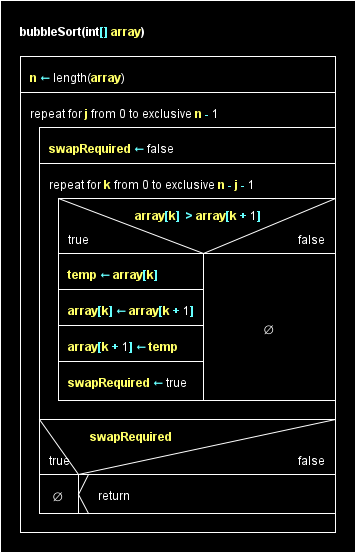Bubble Sort
How Bubble Sort Works
Bubble Sort operates by repeatedly iterating through the input list, comparing each element with the next one, and swapping them if they are in the wrong order. This process is repeated until a complete pass through the list is made without any swaps, indicating that the list is fully sorted. Alternatively (or in combination), you can also omit one more element at the end of each run, as this area has already been sorted in the previous runs. The algorithm gets its name from the way larger elements "bubble" up to the top of the list during the sorting process.
Step-by-step breakdown:
- Start at the beginning of the list:
Compare the first element with the second element. - Swap if necessary:
If the first element is greater than the second element, swap them. - Move to the next pair:
Compare the second and third elements, and swap if necessary. - Continue this process:
Repeat the comparison and swapping until you reach the end of the list. You could also stop at the end of the list minus the zero-based index of the current cycle. - Repeat:
Go back to the beginning of the list and repeat the process for the entire list. - Check for completion:
Continue iterating until a complete pass is made without any swaps. This step is only necessary if you don't decrease the number of comparisons per cycle.

Performance and Practicality
While Bubble Sort is easy to understand and implement, it is not efficient for large datasets. Its time complexity is O(n2), meaning that the time it takes to sort the list grows quadratically with the number of elements. This inefficiency makes Bubble Sort impractical for real-world applications where faster algorithms are available.
When to Use Bubble Sort
- Educational Purposes:
Bubble Sort is perfect for teaching the basics of sorting algorithms and algorithmic thinking. - Small Datasets:
For very small lists, the simplicity of Bubble Sort might be sufficient. - Nearly Sorted Data:
If the data is nearly sorted, Bubble Sort can be more efficient, as it can quickly confirm the sorted order. - Fixed Memory Usage:
Bubble sort has the advantage of requiring a constant amount of memory, making it suitable in environments where memory usage is a concern.
Alternatives to Bubble Sort
For practical purposes, other more efficient sorting algorithms are preferred:
- Quicksort:
An efficient, comparison-based sorting algorithm that uses divide-and-conquer. - Timsort:
A hybrid sorting algorithm derived from merge sort and insertion sort, used in Python's built-in sort function. - Merge Sort:
A stable, comparison-based sorting algorithm that uses divide-and-conquer.
Bubble Sort Code (Java)
Bubble Sort Structogram

Conclusion
Bubble Sort may not be the go-to choice for practical applications due to its O(n2) time complexity, but it holds an important place in the study of algorithms. Its simplicity provides a gentle introduction to sorting techniques and lays the foundation for understanding more complex algorithms. Whether you're a beginner learning the basics or a teacher explaining sorting concepts, Bubble Sort remains a valuable educational tool.


